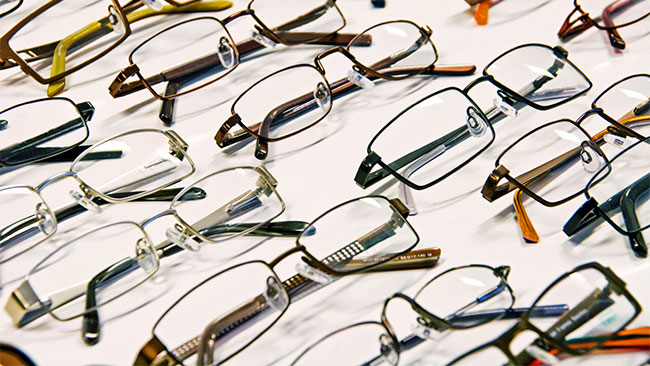This is an article I've been putting off for a long while; not because the topic presents any difficulty, but because it's not that particularly interesting to me. Still, I have to recognize its' importance in the grand scope of eyewear, and also acknowledge that somewhere out there, one of my ten loyal readers might be interested in the subject himself or herself.
It's time to talk about rectangular eyeglasses.

If you're reading this, odds are you're an optician; and if you're an optician, odds are you probably fit more essentially rectangular frames than any other lens shape. Yet there was a time not that long ago when rectangular lenses were an abnormality; a novel shape for novel frames for novel people.
As anyone with even a remove knowledge of eyewear knows, glasses were originally designed primarily for function, with little to no thought given to aesthetics; as such, round frames and frames with rounder edges dominated (aside from practical purposes, older opticians also briefly believed that a lens most perfectly matching the shape and size of a person's eye would provide the sharpest amount of vision; it's easy to imagine how difficult peripheral vision must have been for those unfortunate souls who were fitted by individuals applying this bit of "wisdom"). Though some slightly unique shapes presented around the time of the American Civil War ( see my octagon article), they were still essentially rounded out, and ovals and circles continued to dominate eyewear until well into the 20th Century. It wasn't until the era of bulky plastics (and their close-following cousin, bulky aluminums) that rectangles began to emerge (some primitive models can be seen in photos from the 60s, most notably a sun pair that pops up in photos of George Harrison), with the style enjoying a brief bit of popularity in the 1970s before round frames once again dominated the eyewear market. Then, a confusing and fascinating time known as the 90s rolled around, and it seemed as if eyeglass design would never be the same again.
From a multitude of standpoints, the emergence of rectangles in the 90s makes a great deal of sense. One of the defining traits of Gen X was a desire to radically differentiate themselves from the Baby Boomer generation, so it made sense for them to eschew everything about them, including the round frames favored by prior generations. More generally, eyeglass wearers as a whole were tiring of the uniformity and outdatedness of round frames. Fashion tends to change gears when wearers reach a point of maximum saturation, and by the Clinton era, that point had already long passed. Why wouldn't anyone want to try out something new? Additionally, in terms of strict aesthetics, the rectangle frame made sense in appealing to a broader range of eyeglass wearers concerned about image. Optical superiority not withstanding, round frames were able to thrive as long as they did because they generally suited the facial types commonly found amongst individuals with Anglo-Saxon heritage—a group that comprised a significant portion of the U.S. population for much of the 19th and 20th centuries. However, the massive influx of immigrants to the U.S. in the early and mid 20th century from ethnically diverse parts of the world led to the face shape and structure of the average American itself becoming quite diverse (don't believe me? Here's an easy experiment: Take a yearbook from the 1950s and compare the class photos to a yearbook from the present day). This variation of face shape would, of course, call for an expansion in the number of potential eyeglass shapes in order to accommodate them. In particular, many ethnic groups who immigrated to the U.S. from parts of Eastern Europe tend to have shorter, broader faces, a structure not particularly suited to round frames, which tend to make a shorter face appear rounder and blockier than it already is. For this particular face shape, the rectangle really is the most aesthetically pleasing, giving sufficient peripheral vision while also lengthening and sharpening the face.
So what have I got against rectangles?
Part of it has to do with the rectangle assuming the same position of uniformity once enjoyed by the circle, and people's stubborn refusal to let this go in the face of other considerations. I've had multiple high-minus patients adamantly refuse to wear rounded out frames because they didn't want to "look like Harry Potter." The result of this is numerous pairs of glasses with what could only be described as ridiculous edge thickness generated by rectangular frames—one patient's were so thick he couldn't even close his temples! Then there are those patients who (and I'm going to make myself sound completely awful here) just plain look bad in rectangular glasses, but who don't want to wear anything else—not because they like the way they look in rectangular frames, but because they don't want to stand out. The result is a patient who's still ambivalent about the way he or she looks, and only achieves a modicum of confidence because they're wearing the same shape frames a everyone else—while still feeling internally insecure.
Lastly, I suppose, my grudge against rectangles comes from my own place of frustration. I fall squarely within the group I mentioned above of block-faced descendants of the Eastern European influx to America in the 20th century. I'm also an avowed atavist and retro devotee. The conflict is plain: To achieve a true vintage look, round glasses are called for, but I quite simply have a face built for rectangular frames—the modern product of a modern age. The result is being forced to choose between achieving the look I'd like, and looking good; and that's kind of a lousy conflict, and one I haven't yet completely resolved.
So it is that rectangle frames came into being, and so it is that rectangle frames are here to stay—if not necessarily as the dominant shape (we'll be getting to Normcore and its brigade of George Costanza frames soon enough) then certainly one of the most reliable.
Welcome to the club, rectangles.
Now, I'm going to go listen to my phonograph.

Preston Fassel was born in Houston, Texas and grew up between St. Charles, Missouri and Broken Arrow, Okla.
In 2009, Preston graduated Summa Cum Laude with a degree in Liberal Arts. In 2011, he graduated Cum Laude from Sam Houston State University with a Bachelor's of Science.
Preston currently works as an Optician in the Houston area. His interest in the history of eyewear goes back to his time in high school, when he developed an interest in all things vintage.
In addition to his writing for The 20/20 Opticians Handbook and 20/20 Magazine, Preston is a featured writer for Rue Morgue Magazine, where he reviews of horror and science-fiction DVDs. His fiction writing has been featured three times in Swirl magazine, the literary arts journal of Lone Star College and Montgomery County. He is the author of the definitive work on the life of British horror actress Vanessa Howard, Remembering Vanessa, which appeared in the Spring 2014 edition of Screem Magazine.











